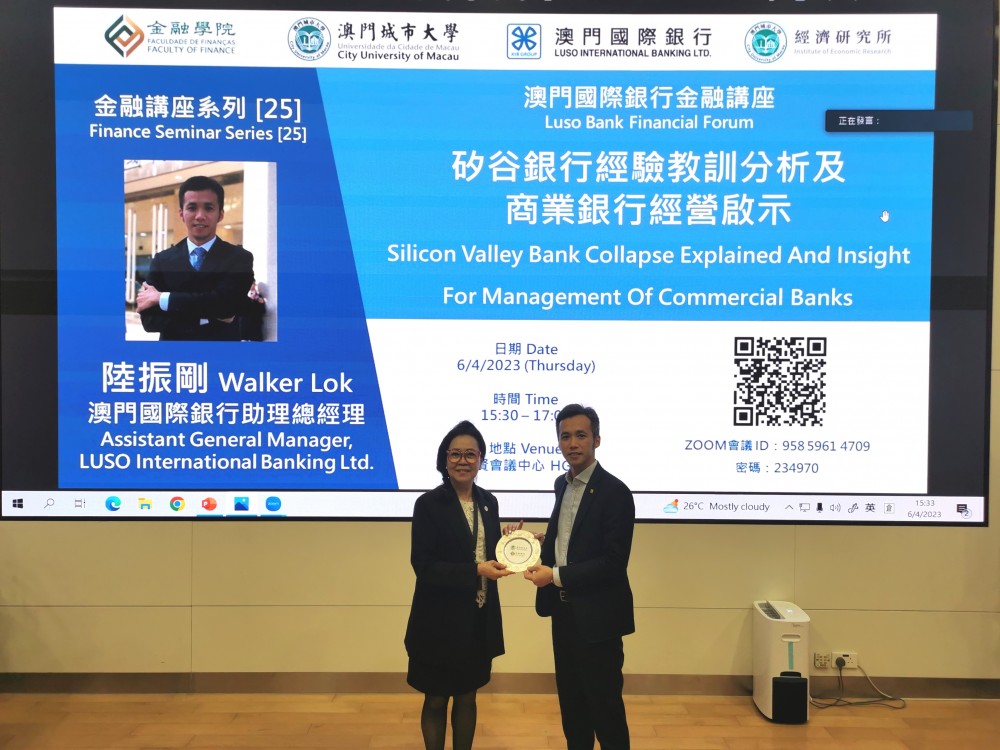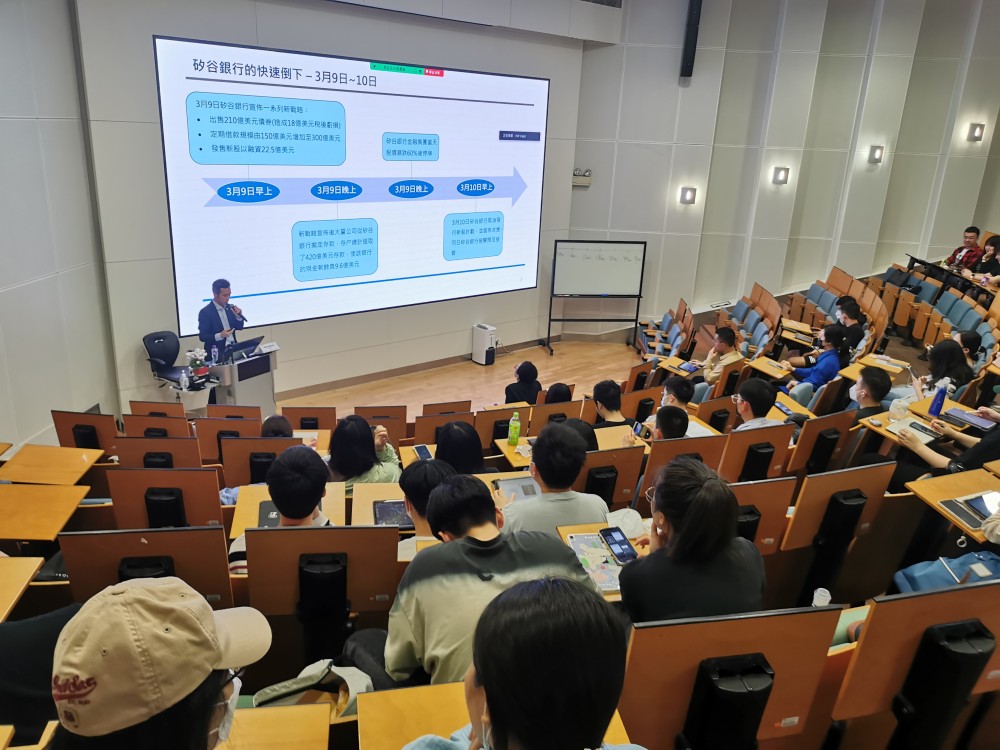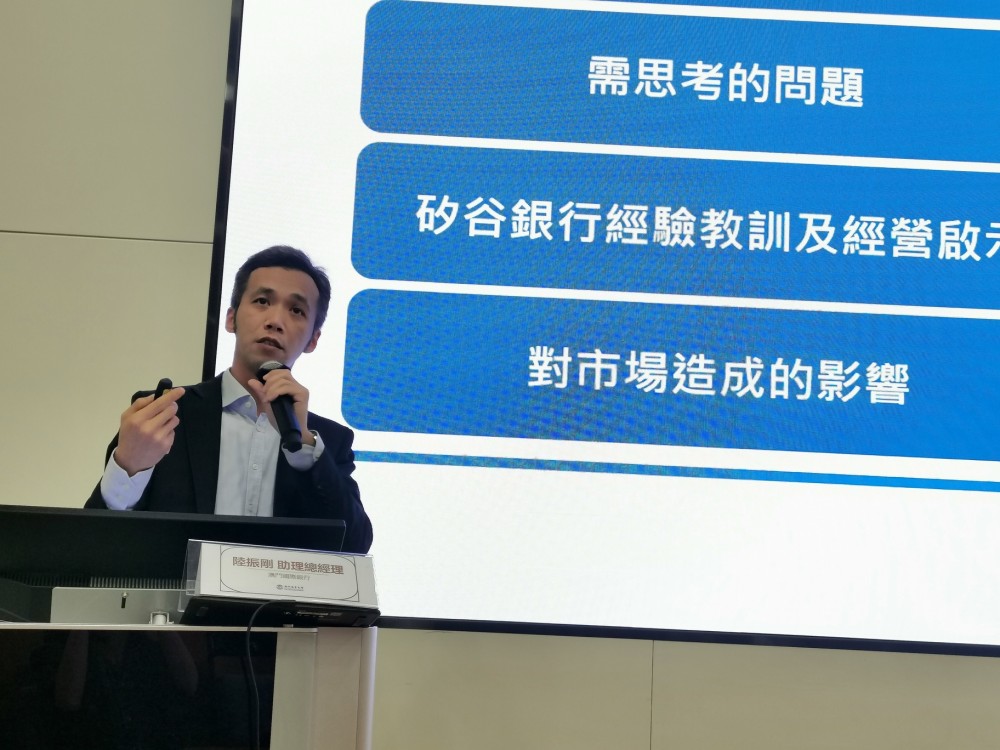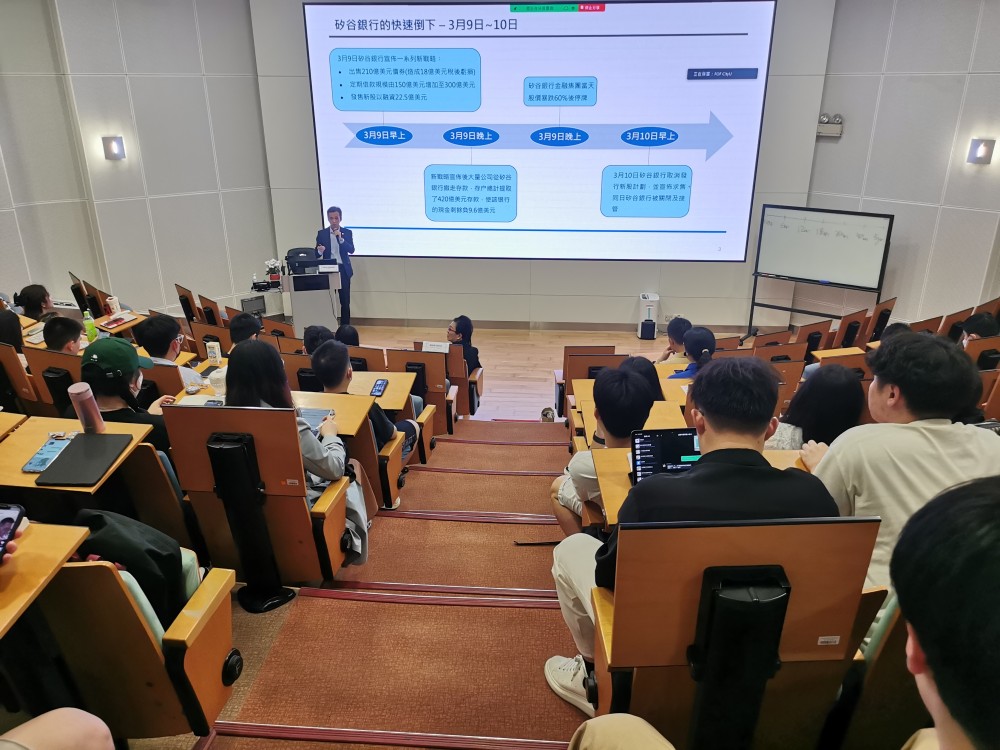On 6 April 2023, the Faculty of Finance of the City University of Macau held the Finance Seminar Series [25] Luso Bank Financial Forum at the Ho Yin Convention Centre. Mr. Walker Lok, Assistant General Manager of Luso International Banking Ltd., was invited to deliver a speech titled “Silicon Valley Bank Collapse Explained and Insight for Management of Commercial Banks”. Guests attending this seminar include Associate Dean Eva Khong of Faculty of Finance, City University of Macau.
Mr. Lok first outlined the collapse of Silicon Valley Bank. On March 9, Silicon Valley Bank announced a series of new strategies, including selling $21 billion of bonds, increasing its term borrowing to $30 billion from $15 billion, and selling new shares to raise $2.25 billion. This led to a large number of corporate withdrawals, with depositors withdrawing a total of $42 billion, leaving $960 million in the bank. Shares of Silicon Valley Bank Financial Group were suspended after plunging 60%. On March 10, it canceled its plan to issue new shares and announced a sale. On the same day, it was closed and taken over. On March 11th, the same day that news broke that Silicon Valley Bank was seeking a buyer for itself, government agencies around the world began sorting out its assets. On March 12, the U.S. Department of the Treasury, the Federal Reserve and the Federal Deposit Insurance Corporation issued a joint statement assuring that Silicon Valley bank depositors would have access to all of their money. On March 13th the Federal Reserve reassured markets by announcing that it would lend to eligible banks for up to a year to ensure liquidity in the banking system.
Next, Mr. Lok introduced Silicon Valley Bank (SVB). Founded in California in 1983 and listed on NASDAQ in 1988, Silicon Valley Bank is the 16th largest bank in the United States and the largest bank by deposits in Silicon Valley, California. It has more than 35 offices worldwide, including in the United Kingdom, China, Israel, Germany, Canada and other countries. As one of the most important banks for science and innovation enterprises, it mainly provides financial services for start-ups, entrepreneurs, venture capital companies, private equity companies and other enterprises. Its business is divided into four parts: SVB, SVB Private, SVB Capital and SVB Securities. In 2012, SPD Silicon Valley Bank, the first Sino-US joint venture bank, was established with Shanghai Pudong Development Bank. From 2019 to 2023, SVB was listed on Forbes Magazine's list of America’s Best Banks for five consecutive years. In 2023, it was first selected to the first Forbes Financial All-Star list. On March 10 of the same year, it was officially closed and taken over.
Mr. Lok analyzed the causes of the Silicon Valley Bank’s collapse. The sources of deposit are highly concentrated in the science and innovation industry, which requires a large amount of capital in the growth period, but it is difficult to generate stable operating cash flow, resulting in the instability of the debt structure. The scale of assets has increased significantly since 2020, but the amount of loans has not kept up with the speed of the number of assets. In order to improve the yield rate, the bank has invested in a large number of long-term bonds, and the extremely long duration has seriously mismatched the maturity of assets and liabilities. In 2022, the Federal Reserve raised interest rates significantly, SVB's deposits decreased, and the cost of liabilities increased substantially. Meanwhile, the rapid rise in the US interest rate caused the price of long-term bonds held to fall sharply, accelerating the outflow of deposits, and resulting in liquidity problems, which led to the sale of securities investment in spite of large losses. The collapse of the Silvergate Bank on March 8 and the delay of Credit Suisse's annual report on March 9 after a call from the U.S. Securities and Exchange Commission made the market sensitive. SVB's new strategy did not take into account market conditions and sentiment, which led to a massive run on the bank.
Due to the Russo-Ukrainian war and the epidemic, global supply chain is experiencing problems, resulting in runaway inflation, and the Federal Reserve's announcement of interest rate hikes, most banks suffered huge losses on bond investment. However, the core problem of SVB was the excessive allocation of long-term investment, resulting in serious maturity mismatch, and internal management of interest rates and market risk was obviously inadequate. In spite of the relaxed regulatory requirements, SVB failed to attach importance to various regulatory indicators and to adhere to the principle of prudent operation. The source of deposit is very concentrated, liquidity stress test and scenario test of interest rate risk should have fully exposed the severity of risk, and capital increase and liquidity supplement plan should also be completed earlier, the management does not pay attention to risk management, and there is a mentality of gambling speculation on the interest rate hike cycle. The market was already in a sensitive state, and SVB did not seriously consider the market sentiment. The new strategic plan further revealed its financial problems, which caused market panic and led to a run on the bank, leaving SVB with no time and space to respond, even without the use of the liquidity facility provided by the Federal Reserve.
Mr. Lok stated that the problem of SVB can be used as a reference for commercial banks. The problem of high concentration of deposit structure can achieve the diversification of liabilities and reduce the concentration of a single customer. For the structural problems of asset allocation, reasonable asset layout, risk measurement and control mechanism can be carried out. On the issue of liquidity management, liquidity measurement should be strictly done to ensure adequate liquidity assets reserve. For public opinion management, it is necessary to establish a public opinion risk response mechanism for bank crisis, implement the risk management system, adhere to the principle of prudence, always pay attention to maintain concentration, promote business on the premise of ensuring stable and sustainable operation of the bank, and avoid radical behaviors such as betting against the market. Lastly, Mr. Lok shared the impact of the SVB’s collapse to the market, including the triggering of market panic, the Credit Suisse issue, small and medium banks’ liquidity problems, etc.
At the end of the sharing session, students took this valuable opportunity to actively pose questions related to the SVB’s collapse and its follow-up, and Mr. Walker Lok answered in detail. In the Seminar, the students paid attention to events in international financial markets, and better understand the current development trend of international finance, which is helpful to grasp the opportunities of the Guangdong-Hong Kong-Macao Greater Bay Area and the internationalization of RMB. The students also expressed their expectations for the sharing of the next finance seminar.














